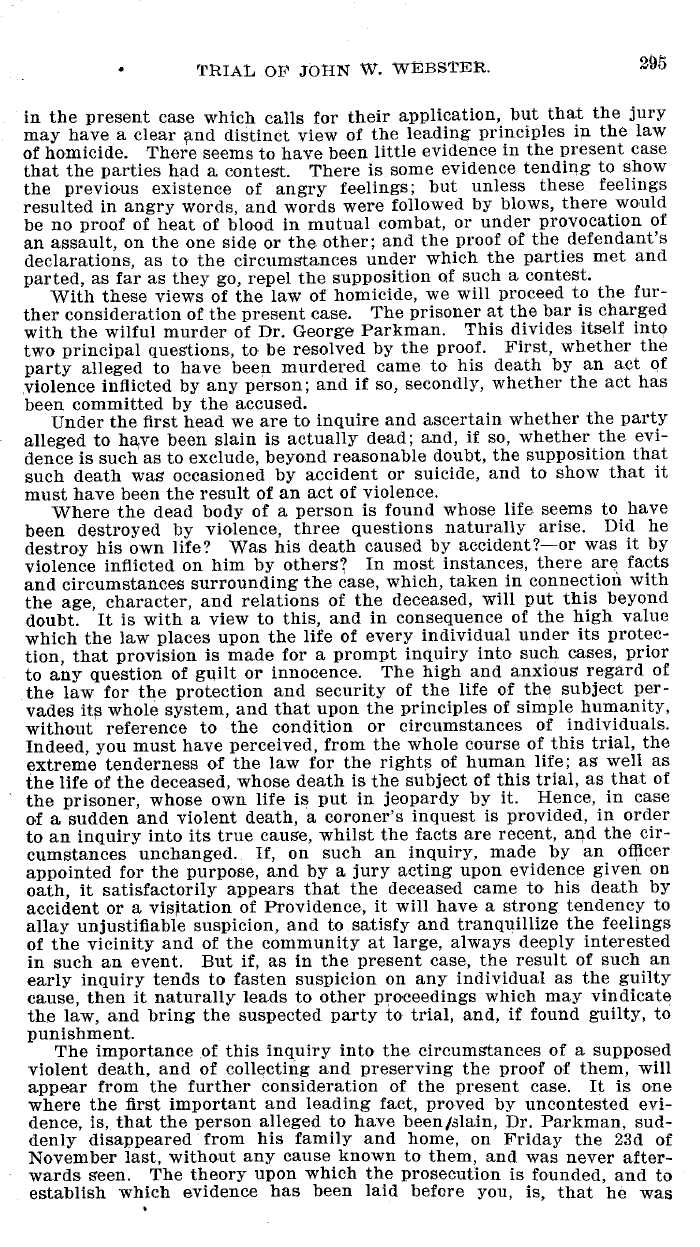|
• TRIAL OV JOTIN W. wMSTER. 295
in the present case which calls for their application, but that the jury
may have a clear and distinct view of the leading principles in the law
of homicide. There seems to have been little evidence in the present case
that the parties had a contest. There is some evidence tending to show
the previous existence of angry feelings; but unless these feelings
resulted in angry words, and words were followed by blows, there would
be no proof of heat of blood in mutual combat, or under provocation of
an assault, on the one side or the other; and the proof of the defendant's
declarations, as to the circumstances under which the parties met and
parted, as far as they go, repel the supposition of such a contest.
With these views of the law of homicide, we will proceed to the fur-
ther consideration of the present case. The prisoner at the bar is charged
with the wilful murder of Dr. George Parkman. This divides itself into
two principal questions, to be resolved by the proof. First, whether the
party alleged to have been murdered came to his death by an act of
violence inflicted by any person; and if so, secondly, whether the act has
been committed by the accused.
Under the first head we are to inquire and ascertain whether the party
alleged to have been slain is actually dead; and, if so, whether the evi-
dence is such as to exclude, beyond reasonable doubt, the supposition that
such death was occasioned by accident or suicide, and to show that it
must have been the result of an act of violence.
Where the dead body of a person is found whose life seems to have
been destroyed by violence, three questions naturally arise. Did he
destroy his own life? Was his death caused by accident?-or was it by
violence inflicted on him by others? In most instances, there are facts
and circumstances surrounding the case, which, taken in connection with
the age, character, and relations of the deceased, will put this beyond
doubt. It is with a view to this, and in consequence of the high value
which the law places upon the life of every individual under its protec-
tion, that provision is made for a prompt inquiry into such cases, prior
to any question of guilt or innocence. The high and anxious regard of
the law for the protection and security of the life of the subject per-
vades its whole system, and that upon the principles of simple humanity,
without reference to the condition or circumstances of individuals.
Indeed, you must have perceived, from the whole course of this trial, the
extreme tenderness of the law for the rights of human life; as well as
the life of the deceased, whose death is the subject of this trial, as that
of
the prisoner, whose own life is put in jeopardy by it. Hence, in case
of a sudden and violent death, a coroner's inquest is provided, in order
to an inquiry into its true cause, whilst the facts are recent, and the cir-
cumstances unchanged. If, on such an inquiry, made by an officer
appointed for the purpose, and by a jury acting upon evidence given on
oath, it satisfactorily appears that the deceased came to his death by
accident or a visitation of Providence, it will have a strong tendency to
allay unjustifiable suspicion, and to satisfy and tranquillize the feelings
of the vicinity and of the community at large, always deeply interested
in such an event. But if, as in the present case, the result of such an
early inquiry tends to fasten suspicion on any individual as the guilty
cause, then it naturally leads to other proceedings which may vindicate
the law, and bring the suspected party to trial, and, if found guilty, to
punishment.
The importance of this inquiry into the circumstances of a supposed
violent death, and of collecting and preserving the proof of them, will
appear from the further consideration of the present case. It is one
where the first important and leading fact, proved by uncontested evi-
dence, is, that the person alleged to have been/slain, Dr. Parkman, sud-
denly disappeared from his family and home, on Friday the 23d of
November last, without any cause known to them, and was never after-
wards seen. The theory upon which the prosecution is founded, and to
establish which evidence has been laid before you, is, that he was
|

